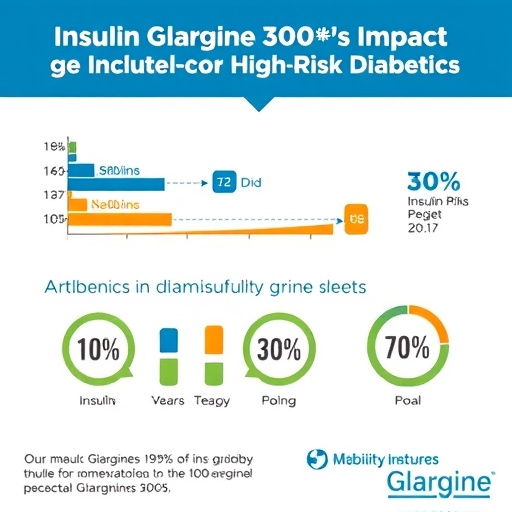In a significant advancement for diabetes care, the recent study led by Tirosh et al. investigates the effectiveness and safety of Insulin Glargine 300 U/ml, particularly focusing on high-risk subgroups such as individuals with renal impairment and those aged 70 years and older. These populations have been historically underrepresented in clinical research, making the findings particularly pertinent in today’s healthcare landscape. As diabetes prevalence rises among the elderly and those with comorbidities, understanding how newer insulin formulations perform in such groups becomes imperative.
The study is a post hoc analysis derived from the real-world ATOS study, which aimed to evaluate the overall safety and efficacy of different insulin therapies for people with Type 2 Diabetes (T2D). The participants included insulin-naïve individuals who were categorized into various demographic and clinical subgroups, allowing for a nuanced examination of how age and renal function impact insulin treatment outcomes. This comprehensive approach shines a light on the potential gaps in current diabetes management strategies for vulnerable populations.
Insulin Glargine, a long-acting basal insulin, has been a cornerstone in the treatment of type 2 diabetes. The specific formulation of 300 U/ml was introduced to provide enhanced glycemic control with a reduced risk of hypoglycemia. Tirosh et al. aimed to assess whether this formulation maintains its safety profile in high-risk populations that often face more complex health challenges. This research is essential for clinicians who need to make informed decisions when prescribing insulin therapies to older adults or individuals with impaired kidney function.
As the study unfolds, it discusses the inherent risks associated with insulin therapy in older adults, such as an increase in falls and other complications due to potential episodes of hypoglycemia. Understanding how different formulations may mitigate these risks is crucial for tailoring diabetes management. The researchers found that Insulin Glargine 300 U/ml not only provides effective glycemic control but also demonstrates an acceptable safety profile in the studied demographics, setting a precedent for insulin use among high-risk patients.
The findings reveal that treatment with Insulin Glargine can lead to improved glycemic outcomes, including reductions in HbA1c, without a significant increase in adverse events, even in those with renal issues or who are aged 70 years and older. This balance of efficacy and safety is critical, especially given the growing population of older adults with multi-morbidities requiring careful management of their diabetes alongside other health conditions. Therefore, the study brings a much-needed perspective to the discussion about insulin therapies in vulnerable populations.
Moreover, the study emphasizes the need for ongoing monitoring and individualized treatment plans for these patients. The results bolster the argument for healthcare systems to develop personalized diabetes management strategies that consider age, kidney function, and other comorbidities. This personalized approach could significantly improve quality of life and health outcomes for individuals battling type 2 diabetes.
With the increasing burden of diabetes, particularly Type 2, among older adults, the role of clinical studies like this cannot be understated. They provide key insights into how treatments can be optimized for specific populations that have historically been excluded from clinical trials. The potential for Insulin Glargine 300 U/ml to fulfill this role could change the landscape of diabetes management, driving better outcomes and enhanced safety for vulnerable groups.
In light of this research, healthcare professionals are encouraged to reassess their patient management strategies. By integrating the findings from Tirosh et al., providers can more confidently prescribe Insulin Glargine to insulin-naïve patients who fall into high-risk categories. The adjustments in practice based on evidence could lead to fewer complications and a shift towards better overall diabetes care.
As diabetes care continues evolving, this study underlines the importance of understanding how treatments affect various subgroups within the population. By continuously exploring and validating treatment efficacy, researchers contribute significantly towards personalized medicine. Future studies should aim to further dissect how insulin therapies can be optimized to accommodate the diverse needs of patients, especially those who are at the highest risk.
In conclusion, the insights provided by Tirosh et al.’s study on Insulin Glargine 300 U/ml herald a new era of diabetes management, where age and comorbid conditions are recognized integral components to treatment success. It invites a proactive discussion surrounding the refinement of treatment protocols to cater specifically to the needs of older adults and those with renal impairments, ultimately paving the way for improved patient outcomes in the field of diabetes care.
Subject of Research: Effectiveness and Safety of Insulin Glargine 300 U/ml in High-Risk Subgroups of Insulin-Naïve People with Type 2 Diabetes
Article Title: Effectiveness and Safety of Insulin Glargine 300 U/ml in High-Risk Subgroups (Renal Impairment and Older Age ≥ 70 years) of Insulin-Naïve People with Type 2 Diabetes: A Post hoc Analysis of Real-World ATOS Study.
Article References: Tirosh, A., Khan, N., Vargas-Uricoechea, H. et al. Effectiveness and Safety of Insulin Glargine 300 U/ml in High-Risk Subgroups (Renal Impairment and Older Age ≥ 70 years) of Insulin-Naïve People with Type 2 Diabetes: A Post hoc Analysis of Real-World ATOS Study. Diabetes Ther (2025). https://doi.org/10.1007/s13300-025-01785-w
Image Credits: AI Generated
DOI: Not provided
Keywords: Insulin Glargine, Type 2 Diabetes, Elderly Patients, Renal Impairment, Safety and Efficacy




